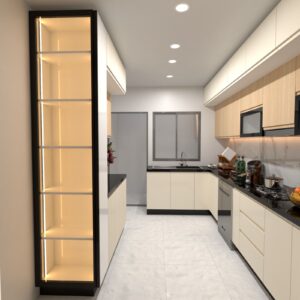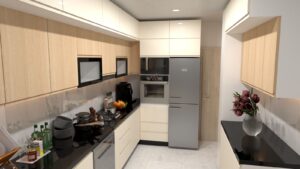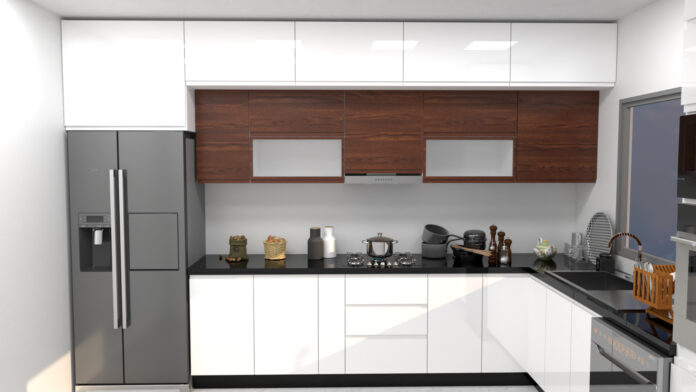The Bsm Kitchen Designer




The Art and Skill of a Kitchen Designer: Transforming Spaces with Function and Style
The kitchen is often considered the heart of a home, a place where family and friends gather, meals are prepared, and memories are made. As such, designing a kitchen requires both creativity and technical knowledge, making it a complex and rewarding job for a kitchen designer. A kitchen designer is not just an interior decorator; they are experts in understanding how the space will be used, the practical needs of the family, and the latest trends in style and technology. Their goal is to create a functional, aesthetically pleasing space that suits the lifestyle of the homeowners while optimizing storage, lighting, and workflow.
What Does a Kitchen Designer Do?
A kitchen designer is responsible for planning and executing the layout, design, and functionality of a kitchen space. They work with homeowners to determine their needs, preferences, and budget, ensuring that the design is tailored to the specific family’s requirements. The kitchen design process typically includes several stages, from consultation and concept development to final installation.
- Consultation and Planning: The first step in the design process is a consultation with the homeowner. During this meeting, the designer will ask questions about the client’s cooking habits, storage needs, and how they envision the space being used. For example, some clients may need a large island for meal prep and entertaining, while others may prioritize storage solutions or energy-efficient appliances.
- Space Measurement and Layout: Once the designer has a clear understanding of the client’s needs, they will take measurements of the space and create a layout. Kitchen design is a blend of art and science, as the designer must ensure that the kitchen functions efficiently. They will consider the « kitchen triangle » concept, which involves the positioning of the refrigerator, stove, and sink to allow for an easy flow of movement during cooking. Additionally, the designer will plan for sufficient counter space, adequate lighting, and storage options.
- Choosing Materials and Finishes: Kitchen designers also help clients choose materials, finishes, and colors. This includes selecting countertops, cabinetry, flooring, backsplashes, and appliances that fit the overall aesthetic and functional goals of the space. Materials such as granite, quartz, and marble are popular for countertops, while hardwood, ceramic tiles, and vinyl are commonly used for flooring.
- Lighting and Electrical Planning: Lighting is another essential aspect of kitchen design. A skilled kitchen designer will plan for multiple types of lighting, including task lighting (focused lighting for tasks such as chopping vegetables), ambient lighting (overall lighting for the room), and accent lighting (to highlight certain features, such as cabinetry or artwork). They will also coordinate with electricians to ensure that there are enough electrical outlets for appliances and that the lighting is positioned effectively.
- Choosing Appliances: Today’s kitchen appliances come in a wide variety of styles, sizes, and functions, and a kitchen designer must help the homeowner select the right ones based on their needs and preferences. From energy-efficient dishwashers and refrigerators to high-end ranges and ovens, the designer must consider how the appliances will fit into the layout and how they will interact with the rest of the kitchen’s design.
- Final Installation: After all the elements have been planned and selected, the kitchen designer works with contractors and installers to bring the design to life. They oversee the installation of cabinets, countertops, and appliances, ensuring that everything is set up correctly and efficiently.
The Skills Required of a Kitchen Designer
Becoming a successful kitchen designer requires a combination of creative and technical skills. While an eye for design and an understanding of aesthetics are essential, there are several other critical competencies that a kitchen designer must possess:
- Creativity and Design Sense: Kitchen designers must be able to visualize the finished product and offer innovative solutions to unique challenges. They should have a strong sense of color, form, and texture and know how to combine these elements in a way that creates harmony and functionality.
- Knowledge of Building Codes and Regulations: Kitchen designers must be familiar with local building codes and regulations, including those concerning plumbing, electrical wiring, and ventilation. This ensures that the kitchen is not only beautiful but also safe and up to code.
- Attention to Detail: In the world of kitchen design, small details can make a big difference. Whether it’s ensuring the precise placement of a cabinet or selecting the right hardware for doors and drawers, attention to detail is critical for achieving a seamless design.
- Project Management Skills: Kitchen designers often work as the project manager for the entire kitchen renovation, coordinating contractors, electricians, plumbers, and other specialists. This requires strong organizational and communication skills to ensure that the project is completed on time and within budget.
- Technical Knowledge: Knowledge of cabinetry construction, materials, appliances, and design software is essential. Many kitchen designers use specialized software to create 3D models and renderings of their designs, allowing clients to visualize the finished space before any work begins.
Current Trends in Kitchen Design
Kitchen design is constantly evolving, influenced by advancements in technology, shifts in lifestyle, and changing design aesthetics. Some current trends that are shaping the future of kitchen design include:
- Smart Kitchens: Technology is playing a bigger role in modern kitchens, with appliances and gadgets designed to make life easier and more efficient. Smart refrigerators, ovens, dishwashers, and faucets can be controlled via smartphone apps, while voice-controlled devices such as Amazon Alexa or Google Assistant can be used to manage tasks like setting timers or adjusting lighting.
- Sustainability: Many homeowners are opting for eco-friendly materials and energy-efficient appliances. Sustainable kitchen design includes using materials like bamboo or recycled glass for countertops, choosing energy-efficient lighting, and opting for low-flow faucets and water-saving dishwashers.
- Open Shelving and Minimalist Design: Open shelving continues to be a popular trend, as it creates a more open, airy feel. It also allows for easy access to cookware and dishes, although it requires a higher level of organization to maintain a tidy appearance.
- Bold Color Schemes: While neutral tones like white, gray, and beige have traditionally been popular in kitchen design, there is a shift toward bolder colors. Deep blues, emerald greens, and even black cabinetry are gaining popularity, offering a striking contrast to lighter walls and countertops.
- Multi-functional Islands: Kitchen islands have evolved from simple meal prep surfaces to multi-functional hubs. Today’s islands may include built-in sinks, wine coolers, cooktops, and even seating areas for casual dining, making them an essential element in many modern kitchen designs.
Conclusion
A kitchen designer plays a critical role in creating spaces that blend aesthetics with function. They must be skilled in design, knowledgeable about materials and appliances, and able to manage projects to ensure that renovations are completed on time and to the client’s satisfaction. As trends in kitchen design continue to evolve, the kitchen designer must stay current with innovations in technology, sustainable practices, and emerging aesthetic preferences. For homeowners looking to remodel or build their dream kitchen, partnering with an experienced kitchen designer can make all the difference in creating a space that is both beautiful and practical.
Key Takeaways
- Role and Responsibilities: A kitchen designer is responsible for creating functional and aesthetically pleasing kitchen spaces. They work with homeowners to understand their needs and preferences, plan the layout, select materials and finishes, choose appliances, and oversee the installation process.
- Skills Required: Successful kitchen designers combine creativity with technical expertise. Essential skills include design sensibility, attention to detail, knowledge of building codes, project management, and proficiency in design software.
- Design Process: The design process typically includes consultation with the client, measuring the space, creating layouts, selecting materials and appliances, planning lighting, and managing the installation of the finished kitchen.
- Current Trends: Kitchen design trends are ever-evolving. Key trends include smart kitchens with technology-driven appliances, eco-friendly designs, minimalist and open shelving styles, bold color schemes, and multi-functional kitchen islands.
- Focus on Functionality: A significant part of a kitchen designer’s job is ensuring that the space is practical and optimized for the client’s daily needs, such as efficient workflows, storage solutions, and adequate lighting.
- Technological Integration: Kitchen designers are incorporating smart appliances and tech features, like voice-controlled systems, energy-efficient devices, and app-controlled gadgets, to enhance convenience and efficiency in modern kitchens.
- Sustainability: With growing environmental awareness, sustainable materials and energy-efficient appliances are becoming a priority in many kitchen designs, promoting eco-friendly and resource-saving practices.
- Project Management: Kitchen designers often oversee the entire project, coordinating with contractors, electricians, and plumbers to ensure everything is installed according to plan, on time, and within budget.
In summary, kitchen designers blend functionality with creativity, staying attuned to trends and innovations while ensuring a customized design that enhances the client’s kitchen experience.
FAQ
1. What does a kitchen designer do? A kitchen designer is responsible for creating functional, aesthetically pleasing kitchen spaces. They work with clients to understand their needs, measure the space, plan the layout, select materials and appliances, and oversee the installation process to ensure everything is done according to the design.
2. Why should I hire a kitchen designer? Hiring a kitchen designer ensures that your kitchen is both beautiful and functional. They have the expertise to optimize your space, select the right materials, and recommend appliances that suit your needs. A designer also helps navigate the complexities of the renovation process, from layout planning to coordinating with contractors.
3. How much does it cost to hire a kitchen designer? The cost of hiring a kitchen designer varies based on the complexity of the project, the designer’s experience, and your location. On average, designers charge a flat fee, hourly rate, or a percentage of the overall project cost. Rates can range from $50 to $200+ per hour, or more, depending on the designer’s reputation and the scope of work.
4. How long does it take to design a kitchen? The timeline for designing a kitchen can vary, but the design phase typically takes between 2-4 weeks. This includes the initial consultation, space planning, material selection, and finalizing the design. The overall project, including installation and construction, may take 6-12 weeks or longer, depending on the complexity and size of the kitchen.
5. What are the latest kitchen design trends? Current kitchen design trends include smart kitchens with technology-integrated appliances, sustainable and eco-friendly materials, minimalist designs with open shelving, bold color schemes, and multi-functional kitchen islands. Designers are also incorporating energy-efficient solutions and focusing on improved lighting and ventilation.
6. How involved will I be in the design process? As a client, your involvement can vary based on your preferences and the designer’s working style. Typically, you will be involved in initial consultations, discussing your needs, preferences, and budget. You’ll also approve design proposals and material selections. Your level of involvement in the installation process will depend on the project scope.
7. Do kitchen designers only work on renovations? No, kitchen designers can work on both renovations and new builds. They help design kitchens for existing spaces and remodel kitchens by updating layouts, cabinetry, appliances, and finishes. They can also work on designing custom kitchens for new homes, ensuring the space meets the homeowner’s needs from the ground up.
8. Can a kitchen designer help me with choosing appliances? Yes, kitchen designers are skilled at recommending appliances that fit both your functional and aesthetic needs. They take into account the layout, energy efficiency, size, and budget when selecting appliances such as refrigerators, dishwashers, ovens, and cooktops.
9. How do I prepare for my first meeting with a kitchen designer? Before meeting with a kitchen designer, it’s helpful to gather inspiration and have a rough idea of your preferences. Consider the layout, style, colors, and materials you like. Also, think about your kitchen’s functionality, such as storage needs, workspace, and cooking habits. Having a set budget in mind is also essential.
10. What is the « kitchen triangle, » and why is it important? The kitchen triangle refers to the optimal placement of the three main work areas in a kitchen: the sink, stove, and refrigerator. The idea is that these elements should form a triangle to allow for efficient movement between them while cooking. A kitchen designer will use this concept to create an efficient layout that minimizes unnecessary steps.
11. What is the difference between a kitchen designer and an interior designer? A kitchen designer specializes in the functionality and design of kitchens, focusing on layout, appliances, ergonomics, and workflow. An interior designer, on the other hand, works on the overall aesthetic of a space, including furniture, color schemes, and decor. While an interior designer can design kitchens, a kitchen designer has more expertise in this specific area.
12. How do I choose the right kitchen designer for my project? When choosing a kitchen designer, look for someone with experience in designing kitchens similar to yours. Check their portfolio and client reviews, and ensure they are licensed and knowledgeable about local building codes. Make sure their style aligns with your vision and that they communicate well with you throughout the design process.
13. Can a kitchen designer help with budgeting? Yes, a kitchen designer can assist in creating a realistic budget based on your goals and preferences. They can help you make cost-effective decisions by suggesting alternatives for materials or finishes, while still achieving the desired look and functionality. A well-designed budget can help prevent overspending during the renovation process.
14. Will a kitchen designer also handle the construction and installation? Some kitchen designers manage the entire project, coordinating with contractors, installers, electricians, and plumbers. However, many designers work in collaboration with other professionals who handle the construction and installation. Be sure to clarify the designer’s role in overseeing these tasks when discussing the project.
15. Can a kitchen designer help with small or unusual spaces? Yes, kitchen designers are skilled at working with spaces of all sizes, including small kitchens or awkwardly shaped rooms. They can come up with creative solutions for maximizing storage, improving functionality, and making the most of limited space, often with custom cabinetry, clever layouts, and smart storage solutions.
Check out this post :https://buzzrival.com/5-things-about-merzouga-moroccan-desert/
Check out our insta : https://www.instagram.com/bsm_kitchens_design/



